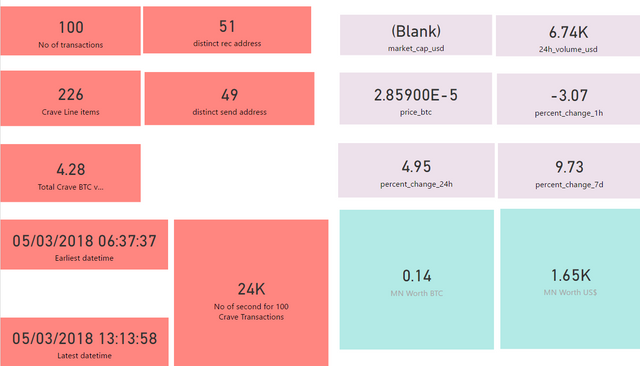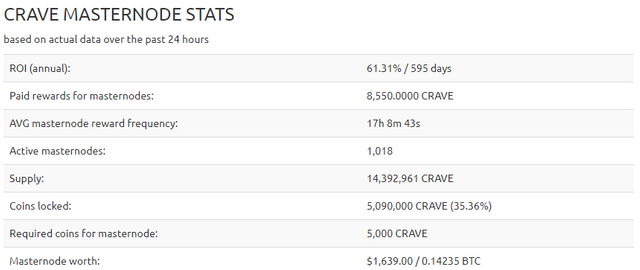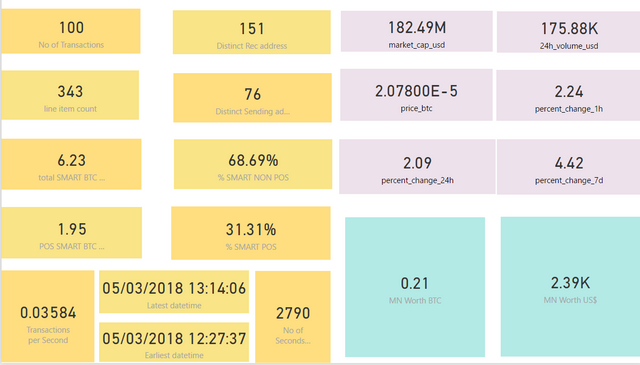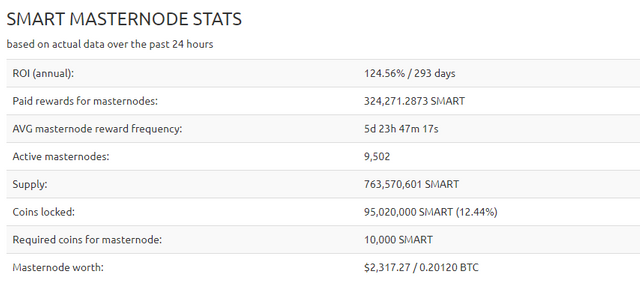Exploring SmartCash and Crave BlockChain Data - BlockChain Business Intelligence
In a previous analysis I looked at transactions on the Smartcash Masternode Blockchain and compared it to Shekel Masternode Blockchain.
If you missed that post you can check it out here
On a quest to make more Masternode data comparisons, today we are going to compare SmartCash with Crave.
Crave, unlike SmartCash is also a POS coin. And they recently completed a swap. As with SmartCash, Crave also has a public API.
Aim of Analysis
The aim of this analysis was
• To explore the data presented in the public API for Crave
• See what insights this data can provide
• Compare Crave to SmartCash
Crave Data

As with APIs previously analysed for MasterNode coins, this API returns the last 100 transactions. However this 100 transactions does not include Masternode or Staking rewards. This is unlike other Masternode APIs that I have looked at to date. It is my opinion, by excluding MN transactions gives a true representation of actual usage on the block.
The last 100 transaction on the blockchain were made up of 226 line items. These 100 transactions moved 4.28 BTC worth of Crave coins from 49 unique addresses to 51 unique addresses.
These 100 transactions took place over 24K seconds. That equates to 0.004 transactions per second.
The values shown in light purple relate to data from Coinmarketcap. At the time of analysis the price of crave was 0.00002859 BTC or $0.31 USD.
Information from Masternodes.online for Crave is shown below

SmartCash Data

The last 100 transaction on the SmartCash blockchain returned by the API includes Masternode rewards.
The non masternode transactions equated to 1.95K in BTC value, however only 31.31% of the transactions in the data set are non Masternode transactions.
In total the 100 transactions took place in 2790 seconds so .03584 transactions per second.
However to compare like with like we must work out how many non masternode transactions there were per second.
The formula used was (0.03584/100)*31.31. That equates to 0.011 non Masternode transaction on the Smart blockchain per second.
The values shown in light purple relate to data from Coinmarketcap. At the time of analysis the price of crave was 0.00002078 BTC or $0.23 USD.
Information from Masternodes.online for Crave is shown below

Comparison
A SmartCash Masternode will costs you 44% more than a Crave Masternode, as a Smart Node requires 10,000 coins and a Crave node costs 5,000 coins. Coin for Coin however Crave at the time of analysis will cost you 34% more.
There is also 2509% more volume traded on exchanges of SmartCash than Crave. However the SmartCash supply is 5205% greater than that of Crave and off the full supply only 12.44% is locked in. Whereas with Crave 35.65% of coins are locked in.
Both the lower supply and the higher % locked in with crave has a major impact in the lower volume traded on exchanges against SmartCash.
Crave processes 0.004 non masternode transactions per second, whereas Smartcash processes 0.001. This makes the Crave blockchain 4X more active than Smartcash.
Conclusion
Masternode Coins have been tipped as the hot thing for 2018 but wading through the rake of Masternode coins to find good ones can be a difficult task.
Comparing the data from one Masternode blockchain against another can provide useful insights that can be combine with other available data as I have done in this analysis.
I am surprised to see that the Crave blockchain is 4X more active and moves so much more in BTC value than Smart but coin for coin Crave is not 4X more expensive.
The Data and Query
The query was pulled at 5th March 2018 13:18 GMT.
The complete M code used in Power BI query editor for SmartCash was:
let
Source = Json.Document(Web.Contents("https://explorer3.smartcash.cc/ext/getlasttxs/10/100")),
#"Converted to Table" = Record.ToTable(Source),
#"Expanded Value" = Table.ExpandListColumn(#"Converted to Table", "Value"),
#"Expanded Value1" = Table.ExpandRecordColumn(#"Expanded Value", "Value", {"_id", "txid",
"blockhash", "__v", "blockindex", "timestamp", "total", "vout", "vin"}, {"_id", "txid", "blockhash", "__v",
"blockindex", "timestamp", "total", "vout", "vin"}),
#"Expanded vout" = Table.ExpandListColumn(#"Expanded Value1", "vout"),
#"Expanded vout1" = Table.ExpandRecordColumn(#"Expanded vout", "vout", {"addresses",
"amount"}, {"addresses", "amount"}),
#"Expanded addresses" = Table.ExpandListColumn(#"Expanded vout1", "addresses"),
#"Renamed Columns" = Table.RenameColumns(#"Expanded addresses",{{"addresses", "Rec
address"}}),
#"Expanded vin" = Table.ExpandListColumn(#"Renamed Columns", "vin"),
#"Expanded vin1" = Table.ExpandRecordColumn(#"Expanded vin", "vin", {"addresses", "amount"},
{"addresses.1", "amount.1"}),
#"Renamed Columns1" = Table.RenameColumns(#"Expanded vin1",{{"addresses.1", "Sending
address"}, {"amount", "sent amt"}, {"amount.1", "rec amt"}}),
#"Added Custom" = Table.AddColumn(#"Renamed Columns1", "total SMART sent value", each
[sent amt]/100000000),
#"Added Custom1" = Table.AddColumn(#"Added Custom", "total SMART Rec value", each [rec
amt]/100000000),
#"Changed Type" = Table.TransformColumnTypes(#"Added Custom1",{{"total SMART Rec value",
type number}, {"total SMART sent value", type number}, {"rec amt", type number}, {"sent amt", type
number}, {"total", type number}, {"timestamp", type number}, {"blockindex", type number}}),
#"Added Custom2" = Table.AddColumn(#"Changed Type", "coin", each "SMART")
in
#"Added Custom2"
The complete M code used in Power BI query editor for Crave was:
let
Source =
Json.Document(Web.Contents("http://explorer.craveproject.net/ext/getlasttxs/10/100")),
#"Converted to Table" = Record.ToTable(Source),
#"Expanded Value" = Table.ExpandListColumn(#"Converted to Table", "Value"),
#"Expanded Value1" = Table.ExpandRecordColumn(#"Expanded Value", "Value", {"_id", "txid",
"blockhash", "__v", "blockindex", "timestamp", "total", "vout", "vin"}, {"_id", "txid", "blockhash", "__v",
"blockindex", "timestamp", "total", "vout", "vin"}),
#"Expanded vout" = Table.ExpandListColumn(#"Expanded Value1", "vout"),
#"Expanded vout1" = Table.ExpandRecordColumn(#"Expanded vout", "vout", {"addresses",
"amount"}, {"addresses", "amount"}),
#"Renamed Columns" = Table.RenameColumns(#"Expanded vout1",{{"addresses", "rec. address"}}),
#"Added Custom2" = Table.AddColumn(#"Renamed Columns", "Coin", each "CRAVE"),
#"Removed Columns" = Table.RemoveColumns(#"Added Custom2",{"vin"}),
#"Added Custom" = Table.AddColumn(#"Removed Columns", "Rec Amt Crave", each
[amount]/100000000),
#"Appended Query" = Table.Combine({#"Added Custom", #"crave (2)"}),
#"Changed Type" = Table.TransformColumnTypes(#"Appended Query",{{"sending amt crave", type
number}, {"sending amount", type number}, {"Rec Amt Crave", type number}, {"amount", type
number}})
in
#"Changed Type"
To get live data from Coinmarketcap, I also connected to the live ticker API for each of the coins and then carried out an append on each of the tables.
The full M code used in Power BI query editor was:
let
Source = Json.Document(Web.Contents("https://api.coinmarketcap.com/v1/ticker/crave/")),
#"Converted to Table" = Table.FromList(Source, Splitter.SplitByNothing(), null, null,
ExtraValues.Error),
#"Expanded Column1" = Table.ExpandRecordColumn(#"Converted to Table", "Column1", {"id",
"name", "symbol", "rank", "price_usd", "price_btc", "24h_volume_usd", "market_cap_usd",
"available_supply", "total_supply", "max_supply", "percent_change_1h", "percent_change_24h",
"percent_change_7d", "last_updated"}, {"id", "name", "symbol", "rank", "price_usd", "price_btc",
"24h_volume_usd", "market_cap_usd", "available_supply", "total_supply", "max_supply", "
percent_change_1h", "percent_change_24h", "percent_change_7d", "last_updated"}),
#"Changed Type" = Table.TransformColumnTypes(#"Expanded Column1",{{"rank", type number},
{"price_usd", type number}, {"price_btc", type number}, {"total_supply", type number},
{"24h_volume_usd", type number}, {"market_cap_usd", type number}}),
#"Appended Query" = Table.Combine({#"Changed Type", #"ticker (2)", #"ticker (3)"}),
#"Appended Query1" = Table.Combine({#"Appended Query", #"ticker (4)"})
in
#"Appended Query1"
Once I had gathered all of the data, I then carried out many calculations using DAX.
I am part of a Blockchain Business Intelligence community. We all post under the tag #blockchainbi. If you have an analysis you would like carried out on Steemit data, please do contact me or any of the #blockchainbi team and we will do our best to help you...
You can find #blockchainbi on discord https://discordapp.com/invite/JN7Yv7j
Posted on Utopian.io - Rewarding Open Source Contributors
Thank you for the contribution. It has been approved.
You can contact us on Discord.
[utopian-moderator]
Interesting write-up. SmartCash is however not a POS (Proof of Stake) coin. It is a POW (Proof of Work) coin using the Keccak Algorithm:
SmartCash Parameters
Coins per Block: 5000 coins (with gradual reduction per equation below)
Blocktime: 55 seconds
Maximum supply: 5,000,000,000
Blocksize: 1 MB (to be changed to Adaptive Blocks)
Algorithm: Keccak
Difficulty Management: BRNDF
There is a tendency for people to mistake it for a POS coin because of the SmartRewards.
SmartRewards are paid out from the 15% of coins mined from each block. The smartrewards do NOT bring the #smartcash into exsitence as in the case of Proof of Stake mining. The holder of 1000+ SMART do NOT need to have their wallets online to earn smartrewards as in the case of staking. The smartrewards are more like "interest" paid to a savings account or fixed deposit account (as the holder has to hold for a fixed period to earn the rewards)
I have updated the above to now say unlike. So are you saying that smart is mined and was not premined? Sorry if I have this wrong...its all a learning curve
Yes smart is being mined, and that's where the smart rewards, node payouts are coming from.....15% and 10% of the blockrewards respectively from all the blocks mined every month.
Hey, no offence here we are all learning and so many things that look the same in cryptocurrency space are actually different. SmartCash was not pre-mined. Like @simplifylife said #smartcash's mining is an ongoing process.
perfect, thanks for the explaination
Nice comparison. I have MN's for both and have been trying to find a way to fairly compare them.
I've read about shekel but unfortunately I do not found smartrewards like feature there.
Transfer 0.200 SBD or 0.250 steem to @mrbean1 and put the link of your post in the public memo I GIVE you FOLLOW AND 5 UPVOT and resteem by @mrbean1
click here to read more about me
wow great write up! keep up the good work!